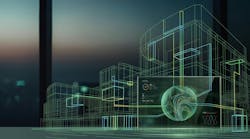Data Centers Support the Growth of the Internet of Things
In this week’s Voice of the Industry, Josh Moody, FORTRUST’s Senior Vice President of Sales and Marketing, discusses the data centers role in making the business and consumer worlds go ’round.
Joshua Moody, VP of FORTRUST
Today, a connection to the Internet is absolutely critical. Many activities require network support, from checking social media and sending emails to video conferencing with colleagues and accessing an employer’s online tools.
Each time you take part in processes like these, you’re using a data center to do so.
As these and other types of technology usage grows, data center support will only become more important. Let’s take a look at just a few of the ways data centers make the world go ’round:
Consumer activities
While enterprises are certainly some of the biggest users of data center computing power, there are a range of consumer activities that wouldn’t be possible without data center support. Many of these are things people do on a daily basis, including:
- Checking online bank statements.
- Connecting with friends on social media.
- Reading news headlines on a smartphone, tablet or laptop.
- Using GPS for driving directions.
- Making online restaurant reservations.
- Streaming music or video services, including Netflix, Spotify and Pandora.
Each time you make a purchase online, post a photo on Facebook or visit a local business’s website, you’re relying on the support of a data center.
Industry processes
Data centers help make a whole host of corporate and industrial processes possible as well. Enterprises all over the world count on data centers for communication capabilities, the ability to access online databases and Web portals, and support for the cloud. A nearly endless list of business practices requires data center computing power, including use of VoIP and video conferencing, accessing the company’s customer relationship management or enterprise resource planning system or even chatting with a co-worker via email.
In fact, 451 Research noted in mid-2015 that businesses have been increasing their data center investments to ensure support for these critical corporate activities. Overall, around 87 percent of North American and European facility operators are sustaining or boosting their data center spending.
“In addition to investing in the cloud and their own facilities, businesses are also boosting spending on colocation.”
“To support growing business demands on IT, enterprises are freeing up budgets and investing in modernizing neglected data center facilities,” 451 Research director Dan Harrington said.
Companies are also increasing their investments in cloud technology, which also requires data center support. According to an Allied Market Research report, the global cloud services market is on track to expand at a compound annual growth rate of about 17.6 percent through 2020, reaching a likely eventual value of $555 billion within the next four years.
In addition to investing in the cloud and their own facilities, businesses are also boosting spending on colocation. Research from Reportbuyer showed that the global colocation market will probably increase at a compound annual growth rate of more than 12 percent in the next few years, reaching $50.18 billion by 2020.
The Internet of Things
As the Internet of Things (IoT) grows, it will require a rising level of data center support as well. Every connected device and appliance will utilize data center computing power – from the thermostat system that is accessible and adjustable, to your cell phone, to the wearable fitness device and that new fridge that reminds you when the milk is getting low.
The IoT brings endless potential to both the consumer and enterprise sectors. Consumer IoT devices, including all the systems being created to establish the smart home and smart car, are becoming more common. In addition, businesses are deploying IoT systems in their offices as well – lighting systems that help reduce energy consumption as well as tracking and monitoring solutions that help better manage available resources.
Internet of Things devices, whether used by consumers or businesses, require considerable data center support.
“The IoT will have a great impact on the economy by transforming many enterprises into digital businesses and facilitating new business models, improving efficiency and generating new forms of revenue,” noted Gartner vice president and analyst Jim Tully.
However, as an estimated 26 billion devices will be connected to the IoT by 2020, the biggest impact occurring here will be felt by data centers. Gartner noted that due to the sheer volume of data traffic related to Internet-enabled appliances and units, the IoT will bring many new challenges for data centers.
“IoT deployments will generate large quantities of data that need to be processes and analyzed in real time,” Gartner research director Fabrizio Biscotti pointed out. “Processing large quantities of IoT data in real time will increase as a proportion of workloads of data centers, leaving providers facing new security, capacity and analytics challenges. Data center managers will need to deploy more forward-looking capacity management in these areas to be able to proactively meet the business priorities associated with IoT.”
For all these, and more Internet-centered activities to be possible, the data centers supporting them have to be up and available 24 hours a day, seven days a week. Is your data center up for this challenge?
Josh Moody is the Senior Vice President of Sales and Marketing for FORTRUST. Josh is a regular guest contributor to Data Center Frontier. FORTUST recently celebrated 14 years of continuous systems uptime at their Denver data center, signaling a commitment to providing the necessary support for today’s internet centered economy.


